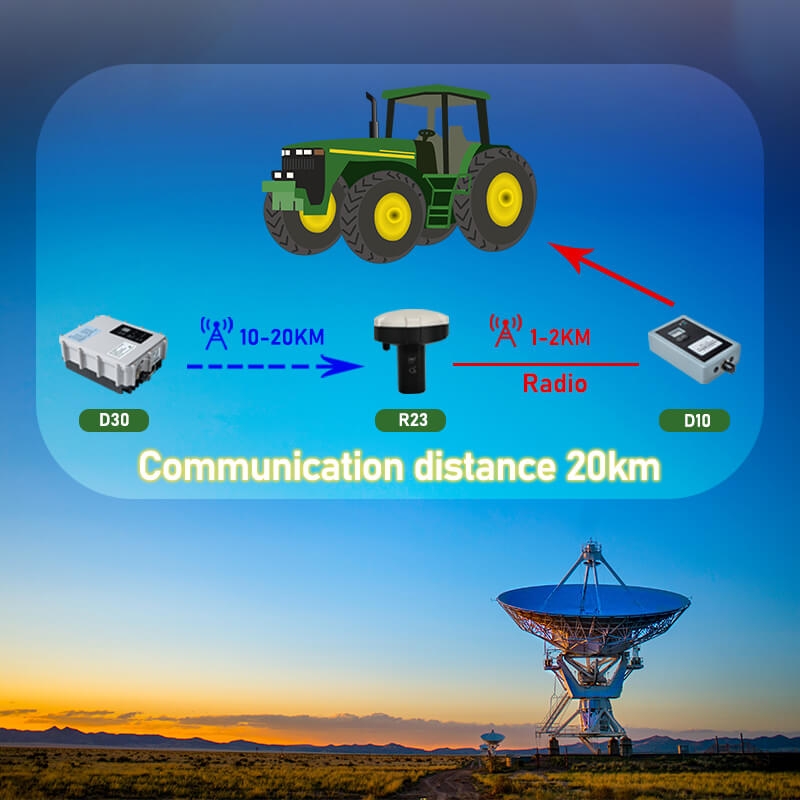This article will cover the potential benefits of the RTK auto-steer system for precision agriculture, as well as how they may begin using it right now. Consequently, let’s begin by defining RTK and determining whether or not this helps.
Real-Time kinematics, often known as RTK, is a technique for improving the accuracy of a standalone global navigation satellite system (GNSS) receiver. GNSS receivers that are standard, such as the ones in your smartphones, have a positioning accuracy that is no better than 2-4 meters at most. However, GNSS RTK receivers can bring you to within a few centimeters of your target, so this shouldn’t be an issue. Consequently, RTK is the technology that allows for the success of today’s precision farming.

How do they work?
- To determine the precise location of the GPS receiver, the RTK system takes into account both the satellite positioning information that was received by the GPS receiver as well as a correction to that information that was received from a “base station” in the immediate area.
- The adjustment is computed at the base station many times per second by comparing its constantly-evolving theoretical location to its known, fixed position as reported in real-time by the same satellites that the receiver uses to determine its position. This comparison is carried out by comparing the base station’s constantly-evolving theoretical location to its known, fixed position.
- It Creates opportunities for multiple increases in productivity that is allowed by technological advancements:
- The farmer must first implement the RTK guidance and precise tractor guiding to be able to reap the benefits of cutting-edge precision agriculture technology such as VRT (Variable Rate Technology) and the incorporation of GIS heat maps produced by soil sensors, drones, or satellite photography.
- In addition, in order for a farmer to reap the benefits of cutting-edge precision agriculture technology farmers must choose their RTK guidance system from a reliable brand like SMAJAYU!
Advantages of using RTK auto-steer system for precision agriculture:
Economic:
Because the accuracy of your tractor is improved, this means that you have to do fewer passes around your field, resulting in reduced field costs and improved efficiency of work.
- The yield will increase as a result
- Manual or lightbar steering doesn’t hold the same accuracy as auto steering, due to evident human error, this means that patches are at times skipped, resulting in reduced yield. This often happens when acquiring the line and is aggravated in conditions of complex field geometry, obstacles, and uneven terrain.
- When it comes to manual and lightbar steering, there is a 6-9% overlap area between the passes. Using RTK reduces that to 0.5%.
Decreased Input costs:
Increased tractor accuracy results in fewer passes being made over the field, which in turn reduces the amount of money spent on the field and increases the work that can be done in the same amount of time. enhanced accomplishments
Because of the inherent possibility of human mistakes, manual or lightbar steering does not have the same level of accuracy as automated steering. As a result, patches are often disregarded, which results in decreased output. This happens rather often throughout the line acquisition process, and it is made worse by elements such as intricate field geometry, impediments, and undulating terrain. There is a zone that overlaps between the passes for manual steering and lightbar steering that is between 6 and 9 percent. The use of RTK might bring that percentage down to 5%.
Repeatability:
The capability of the RTK system to remember and recall the operator’s routes makes high-precision activities like in-row weeding and cultivation much simpler. As a result, soil compaction is reduced, and the integrity of the planted rows is preserved. Because the coordinates of the motion path are saved, you will always be able to start up exactly where you left off the day before.
Efficiency:
An autonomous control system boosts productivity by relieving the farmer of the responsibility of paying attention to the steering of the tractor. This, in turn, reduces the likelihood that the operator may sustain an injury since they are able to devote more of their attention to the implementation. Agriculture is adjusting to taking advantage of the day-to-day developments in technology by increasing its level of adaptability in order to achieve maximum output.
Innovating farming technologies are making farms more profitable
As was said before, progressive agricultural practices are enabling farmers to expand their revenue while preserving their land holdings. In the past, the amount spent on traditional labor might have accounted for as much as 75 percent of the overall cost of a crop. Many farmers were forced to give up their property since it became economically prohibitive for them to continue cultivating their land and raise their families there. Tractor autosteer systems and other kinds of automated agricultural technology now enable machines to do many of the repetitive and labor-intensive chores that was formerly handled by humans. In the past, these tasks were traditionally carried out by individuals.
The innovative farming technology of SMAJAYU not only automates farming procedures, but also assists landowners in maximizing productivity by taking the qualities of the soil into consideration and modifying irrigation, fertilization, and other agricultural practices appropriately.
Final thoughts:
It is impossible to avoid the fact that new technology for agriculture is causing a sea change in the manner that farming is practiced. Farmers need to be able to adapt to the rapidly shifting agricultural environment, which is dominated by labor shortages and rising land prices, in order to ensure that they can remain profitable and even achieve higher yields and profits than they have ever achieved before. This requires them to invest in new technology like RTK auto-steer system for precision agriculture.


